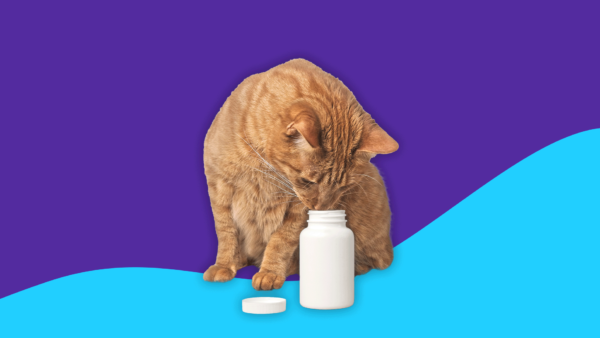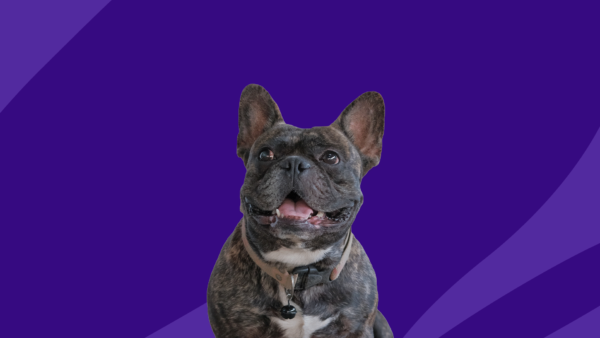Trazodone is an FDA-approved antidepressant drug that has been found helpful in treating individuals with post-traumatic stress disorder (PTSD). Originally a human medication, this drug has gained popularity in veterinary medicine for its ability to help reduce symptoms of canine anxiety and increase behavior calmness. Dogs often suffer from separation anxiety, fear-based anxiety, and stress-related anxiety from aging. Trazodone is an effective medicine that can greatly reduce your pet’s anxiety and associated behavioral disorders.
How much trazodone can I give my dog?
The standard dose of trazodone is approximately 1 to 3 milligrams per pound of the dog’s body weight. For example, if a dog weighs 23 pounds the animal dose of trazodone is in the 23 mg to 70 mg range. Trazodone is often prescribed for surgical procedures on animals. A veterinarian can prescribe the appropriate amount for your pet. When used for treating anxiety, it is better to start with a lower dose and only take higher doses as needed.
Medication routines will vary depending on whether the medicine is needed for short-term stress relief or long-term management of anxiety. The veterinarian may suggest anti-anxiety medication to be given every 6, 8, or even up to every 24 hours for ongoing anxiety disorders. Reducing situational stress may require medication to be given an hour or two before the event or on an as-needed basis. Be sure to follow the safety guidelines for trazodone dosage based on weight.
Trazodone for dogs dosage chart |
||
|---|---|---|
| Weight | Starting dosage | Max dosage |
| 5lbs. | 7 mg | 16 mg |
| 6- 10 lbs. | 12.5 mg | 32 mg |
| 11- 15 lbs | 25 mg | 50 mg |
| 16-20 lbs. | 25 mg | 62.5 mg |
| 21-25 lbs. | 37.5 mg | 75 mg |
| 26-39 lbs. | 50 mg | 100 mg |
| 40-44 lbs. | 50 mg | 125 mg |
| 45-49 lbs. | 62.5 mg | 150 mg |
| 50-54 lbs. | 75 mg | 150 mg |
| 55-59 lbs. | 75 mg | 175 mg |
| 60-64 lbs | 75 mg | 200 mg |
| 65-69 lbs. | 100 mg | 200 mg |
| 70-80 lbs. | 100 mg | 250 mg |
| 81-94 lbs. | 125 mg | 250 mg |
| 95-99 lbs. | 125 mg | 300 mg |
| 100-115 lbs. | 150 mg | 300 mg |
| 120+ lbs. | 162.5 mg | 300 mg |
Source: Whole Dog Journal
According to Dr. Ray Spragley DVM CVA CCRT, a veterinarian at Zen Dog Veterinarian Care, “Trazodone for dogs is the same for people. They can take the human form at a dose given by their veterinarian.” It is important to check with your vet to determine if trazodone is the best treatment for your pet.
Anxiety in dogs may occur for a variety of reasons. Fear-based anxiety, age-related anxiety, and separation anxiety are three common variations of anxiety. Knowing what type of anxiety your dog has can allow you to help your pet better.
Separation anxiety often occurs when the pet is apart from their main care person or people. According to the National Institute of Health, in 2022 approximately 20 percent of canines suffer from separation anxiety. Separation anxiety symptoms often include whining, panting, clawing at closed doors, peeing and pooping in the house, and destroying furniture, clothing, shoes, and pillows.
Dogs that are stressed by strangers, other animals, veterinary visits, and loud noises such as thunderstorms or fireworks may be experiencing fear-based anxiety. According to a study with more than 26,000 participants, 41% of pet parents claimed that their dogs showed signs of being anxious or fearful in mild to moderate amounts while at vet appointments. An additional 14% of pet owners stated their dog’s anxiety symptoms were severe while at the veterinarian’s office.
Dogs with fear-based anxiety may be aggressive, bark, growl, and bite. Fear-related anxiety may subside on its own or need some conditioning or training as well as medication or herbal supplements for treatment. Anxiety related to a specific situation may only need medication for short-term use. To reach full effect, medications and supplements used to treat situational anxiety should be given to the dog at least one hour before a stressful event.
Age-related anxiety is another type of stress that develops as the pet becomes older and loses memory and cognitive function. A dog may display repetitive behavior, pacing, panting, and drooling as part of their anxiety. Anxiety associated with aging can often be supported with homeopathic treatments, medication, as well as extra physical care and companionship. To avoid adverse effects such as liver damage, seek medical advice from a veterinarian before giving trazodone or other medications to senior dogs.
What is the max trazodone dose for dogs?
According to the American Society for the Prevention of Cruelty to Animals (ASPCA) it is important to titrate or slowly increase the amount of medication by small amounts over a given period of time such as days, weeks, or even months. A lower dose may be all your dog needs. In most cases, even with severe anxiety, the smaller the dog the less medication it can take.
Monitor the dog for the effectiveness of medication. Gradually increase the dose as needed but do not administer more than the maximum amount for the dog’s size and weight. Trazodone tablets come in 50 mg, 100 mg, 150 mg, and 300 mg and are scored down the center to allow for various dosing.
Can dogs overdose on trazodone?
Yes, dogs can experience a drug overdose. Too much trazodone can cause serotonin syndrome or excessive levels of serotonin in the body. While serotonin is a natural chemical in a dog’s body, like humans, to help regulate mood; too much can also cause problems. Signs of serotonin syndrome can include restlessness, agitation, decreased appetite, increased heart rate, difficulty breathing, muscle spasms, hyperthermia, seizures, vomiting, lethargy, disorientation, drooling, blindness, difficulty walking, or an increase or drop in blood pressure.
A trazodone overdose could cause serious adverse effects, permanent damage to bodily functions, or even death. While side effects of trazodone are rare, seek emergency veterinarian support if your dog is experiencing any of the previously listed symptoms. Symptoms may appear anywhere from 30 minutes to 12 hours after medication is ingested.
Dogs that have consumed too much trazodone may be taken into veterinarian care for observation and could be given IV fluids and activated charcoal as part of treatment. Depending on the age and general health of the dog, most cases of serotonin syndrome associated with trazodone overdose are reversible and will clear within 24-72 hours.
How to give your dog trazodone
Trazodone comes in tablet form and needs to be given to your pet orally. For oral administration, the pill can be tucked into an appropriate treat or food such as bread or peanut butter. Special treats are also available with a pouch for pills to be inserted. If your pet has difficulty swallowing or taking pills, trazodone can be crushed and placed in food or water to be consumed. Although it is better not to give your pet this medication on an empty stomach there are also techniques to assist your dog’s medicine intake without the use of food.
As many medications suggest, if you miss a dose of trazodone for your pet you should give the animal the dose as soon as you remember and begin the intervals from the new time. If you miss a dose and are getting close to the next dose time skip the missed dose and resume medicine at the next scheduled time.
Trazodone interactions with other pet medications
Some dogs should not take trazodone. Dogs with liver disease, kidney disease, or heart disease should avoid medications like trazodone or may need a lower dose. While trazodone is often a helpful medication for dog anxiety there are some potential drug interactions. Medications such as heart medicine, aspirin, non-steroidal anti-inflammatory drugs, gastrointestinal medication, diuretics, and some antibiotics may cause interactions to occur.
To avoid overdose, drug interaction, or other potential side effects tell your vet about any medical conditions, medications, or supplements the dog is taking. If your dog is pregnant or becomes pregnant discontinue the use of trazodone and consult your veterinarian. Trazodone use on pregnant pets can have adverse effects on the developing fetus. Other medications may be substituted.
Trazodone alternatives for dogs
Trazodone is just one of many anti-anxiety medications your veterinarian may prescribe for your dog. Antidepressants and Selective Serotonin Reuptake Inhibitors (SSRIs) are other categories of medicine that can be helpful for anxious dogs. Trazodone sometimes has a sedative effect on pets. Ask your vet about the wide range of alternative prescription drugs used to treat anxiety disorders such as:
- Alprazolam (Xanax)
- Fluoxetine (Reconcile or Prozac)
- Diazepam (Valium)
- Amitriptyline (Elavil)
- Clomipramine (Clomicalm)
- Gabapentin(Neurontin)
- Busprione (BuSpar)
- Dexmedetomidine (Sileo)
- Lorazepam (Ativan)
- Fluoxetine (Reconcile or Prozac)
- Paroxetine (Paxil)
- Sertraline (Zoloft)
Whether trazodone or other prescription medications work for your pet’s needs or not, there are alternatives to consider as well. Using a variety of strategies can play an important role in maximizing your dog’s well-being. Sabrina Kong, DVM and contributor to We Love Doodles states, “While trazodone can be highly effective in reducing pet stress, combining medication with behavior modification techniques is vital. Working with a personal dog trainer or veterinary behaviorist can provide strategies to help manage anxiety triggers and teach coping mechanisms to dogs.” Many homeopathic remedies and pet-specific supplements are available to reduce stress and anxiety. For example:
- Exercise is a great way to help your dog use excess energy that is sometimes associated with anxiety. Exercise on a daily basis is also beneficial for puppies and dogs with hyperactivity disorders.
- Dog trainers are an excellent resource for helping dogs overcome behavior issues with lasting results.
- Calming music may also be beneficial to reducing your pet’s stress levels and improving the dog’s behavioral problems.
- Physical contact, essentially love and attention, can play a role in reducing anxiety during stressful situations. Massage is another way to relax your pet, this is great for all dogs, especially older pets and dogs that suffer from noise phobias.
- Television can be used to help reduce a dog’s separation anxiety. Leaving the TV on when the owner is away is one strategy that could help ease the dog’s stress while spending time alone.
- Melatonin can potentially reduce stress and anxiety associated with hormone-related disorders. Treats, chewables, and liquid forms are available.
- Calming pheromones can naturally reduce anxiety for dogs. These come as sprays, diffusers, and collars.
- Chamomile flower is another anxiety-reducing remedy. Available in tea, powder, tincture, and dog treat form.
- Lavender is a relaxing herb. Made for dogs in a spray, liquid form, roller, chewable, and treat form.
- Ginger Root can help ease an upset stomach associated with stress. This comes in liquid, chewable, and treat forms.
It is important to remember to consult a veterinarian before treating your dog with homeopathic remedies such as essential oils and supplements. Some essential oils used in humans can be harmful to your dog. Use caution when using herbal remedies. Discontinue use if your dog has a negative response such as an allergic reaction.
Sources
- The evolving use of trazodone for dogs, Whole Dog Journal (2022)
- Consider canine separation anxiety as you return onsite, National Institutes of Health (2022)
- Investigating risk factors that predict a dog’s fear during consultation, Public Library of Science (2019)
- Understanding trazodone toxicosis, The American Society for the Prevention of Cruelty to Animals (2023)
- Trazodone for dogs: What to know, American Kennel Club (2023)
- Serotonin Syndrome, Iowa Veterinary Specialities (2019)
- Giving oral medications to your dog, Washington State University College of Veterinary Medicine (2022)











